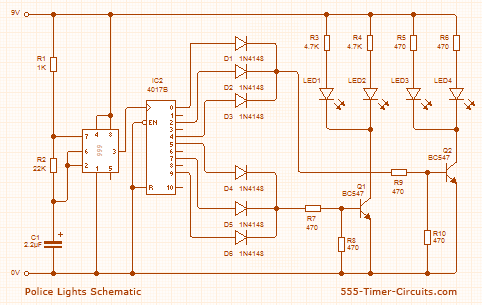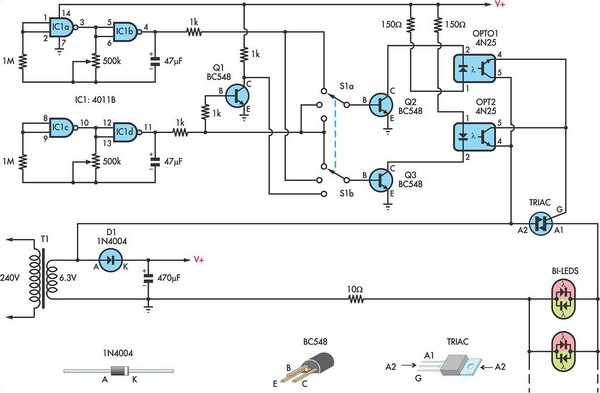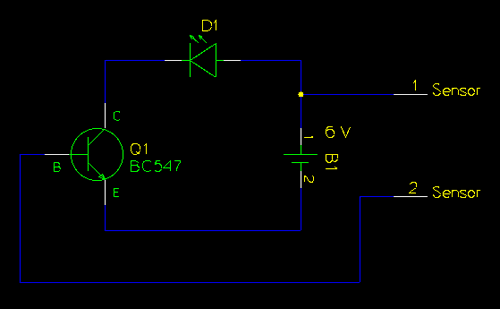
police lights

This circuit utilizes a 555 timer configured to operate in astable mode. This configuration produces a continuous output at Pin 3 in the form of a square wave. When the timer's output transitions to a high state, it triggers the 4017 decade counter to activate the next sequential output. The outputs of the 4017 are connected to LEDs, controlling their illumination.
The circuit begins with the 555 timer, which is set up in astable mode. In this mode, the timer oscillates continuously, generating a square wave signal at a specific frequency determined by the values of two resistors and a capacitor connected to it. The output at Pin 3 alternates between high and low states, creating a periodic signal.
This output signal is fed into the clock input of the CD4017 decade counter. The CD4017 is a versatile counter that counts from 0 to 10 and provides a high signal at one of its ten output pins for each clock pulse it receives. As the 555 timer generates a square wave, each rising edge of the signal increments the count of the 4017, sequentially activating its output pins.
The outputs of the 4017 are connected to a series of light-emitting diodes (LEDs). Each time the 4017 counts up, it turns on the corresponding LED while turning off the previous one. This creates a visual effect where the LEDs appear to light up in sequence. The timing of the 555 timer can be adjusted by changing the resistor and capacitor values, allowing for control over the speed of the LED sequence.
Overall, this circuit effectively demonstrates the use of a 555 timer in conjunction with a decade counter to create a simple LED chaser effect. The design is straightforward, making it suitable for educational purposes as well as practical applications in decorative lighting displays.This circuit uses a 555 timer which is setup to both runn in an Astable operating mode. This generates a continuous output via Pin 3 in the form of a square wave. When the timer`s output changes to a high state this triggers the a cycle on the 4017 4017 decade counter telling it to output the next sequential output high. The outputs of the 4017 ar e connected to the LEDs turning them on and off. 🔗 External reference
The circuit begins with the 555 timer, which is set up in astable mode. In this mode, the timer oscillates continuously, generating a square wave signal at a specific frequency determined by the values of two resistors and a capacitor connected to it. The output at Pin 3 alternates between high and low states, creating a periodic signal.
This output signal is fed into the clock input of the CD4017 decade counter. The CD4017 is a versatile counter that counts from 0 to 10 and provides a high signal at one of its ten output pins for each clock pulse it receives. As the 555 timer generates a square wave, each rising edge of the signal increments the count of the 4017, sequentially activating its output pins.
The outputs of the 4017 are connected to a series of light-emitting diodes (LEDs). Each time the 4017 counts up, it turns on the corresponding LED while turning off the previous one. This creates a visual effect where the LEDs appear to light up in sequence. The timing of the 555 timer can be adjusted by changing the resistor and capacitor values, allowing for control over the speed of the LED sequence.
Overall, this circuit effectively demonstrates the use of a 555 timer in conjunction with a decade counter to create a simple LED chaser effect. The design is straightforward, making it suitable for educational purposes as well as practical applications in decorative lighting displays.This circuit uses a 555 timer which is setup to both runn in an Astable operating mode. This generates a continuous output via Pin 3 in the form of a square wave. When the timer`s output changes to a high state this triggers the a cycle on the 4017 4017 decade counter telling it to output the next sequential output high. The outputs of the 4017 ar e connected to the LEDs turning them on and off. 🔗 External reference





